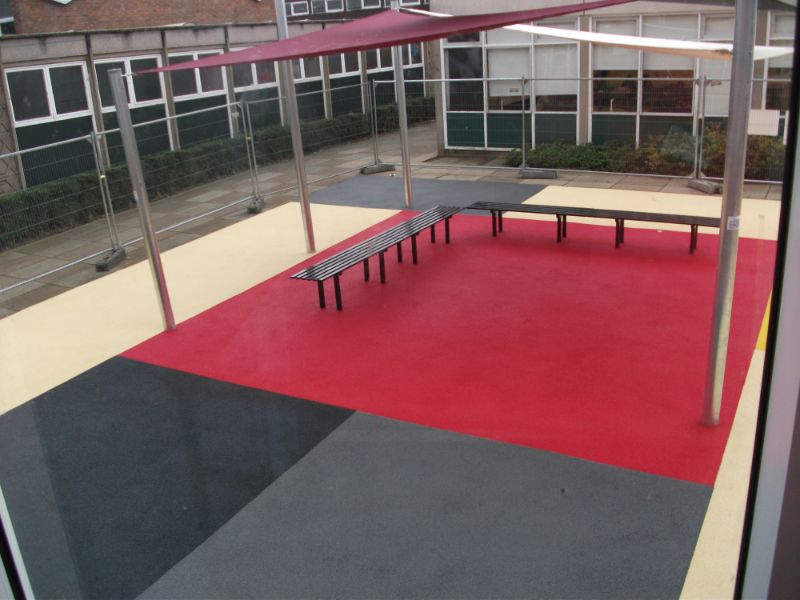20+ Years Experience
Specialist Playground Resurfacing

Enquire Today For A Free No Obligation Quote
Playgrounds are a vital part of childhood, providing kids with the opportunity to play, learn, and grow. However, with the fun comes a degree of risk. According to a study by RoSPA, there are over 40,000 child accidents each year in the UK, with many of these happening on playgrounds. Choosing the right type of surface for your playground is essential to reduce this risk.
In this article, we’ll outline the top 8 types of playground surfaces in the UK and their advantages and disadvantages to help you make an informed decision.
Wetpour surfacing is a popular choice for playgrounds in the UK, as it is safe, durable, and low maintenance. It’s made from a rubber compound that is mixed and laid on-site. Wetpour provides a cushioned surface that absorbs impact, reducing the risk of injury if a child falls.
Suitable for a wide range of playgrounds, including nurseries, schools, and public parks.
Available in various colours and designs, allowing for customisation and creativity.
Resistant to weather conditions and UV light, making it ideal for the UK climate.
It can be expensive to install
Requires a professional installation to ensure proper safety standards
Artificial grass has become increasingly popular for playgrounds due to its low maintenance and attractive appearance. In addition, it provides a soft, cushioned surface perfect for children to play on.
Low maintenance, as it doesn’t need mowing, watering, or weeding.
Durable and long-lasting, with an expected lifespan of up to 20 years.
Resistant to weather conditions and UV light.
It can be expensive to install, particularly for larger areas.
In addition, it can get hot in direct sunlight, making it uncomfortable for children to play on.
Grass matting is a cost-effective and low-maintenance option for playgrounds. It’s made from recycled rubber and provides a non-slip, cushioned surface.
Easy to install, as it can be rolled out and cut to size.
Affordable and cost-effective.
Non-slip surface, even in wet conditions.
Not as durable as other options, with a lifespan of around 5-10 years.
It can fade over time in direct sunlight.
Resin-bound gravel is popular for playgrounds due to its natural appearance and low maintenance. It’s made by mixing natural gravel with a clear resin, which is then poured onto the surface.
Natural appearance, blending in well with the surrounding environment.
Low maintenance, as it doesn’t require mowing, watering, or weeding.
Non-slip surface, even in wet conditions.
It can be expensive to install, particularly for larger areas.
Not as durable as other options, with a lifespan of around 5-10 years.
Rubber mulch is made from shredded rubber and is a popular choice for playgrounds due to its safety and low maintenance. In addition, it provides a cushioned surface that absorbs impact and reduces the risk of injury.
They are made from recycled materials, making them environmentally friendly.
Long-lasting, with a lifespan of up to 10 years.
Non-slip surface, even in wet conditions.
It can be expensive to install.
In addition, it can retain heat, making it uncomfortable and potentially dangerous during our warm summer months for children to play on.
Natural grass is a traditional and popular playground option, but it requires regular maintenance to keep it looking its best. Grass needs to be mowed, watered, and fertilised, and it can become muddy and slippery in wet conditions.
Low cost, as it’s a natural and readily available material.
Soft and comfortable to play on, making it an ideal surface for young children.
They are aesthetically pleasing and blend well with the surrounding environment.
High maintenance, requiring regular watering, mowing, and fertilising.
It can become muddy and slippery in wet conditions, increasing the risk of injury.
Poured-in-place rubber is a type of playground surfacing made by mixing rubber granules with a binding agent and pouring the mixture onto the ground. This creates a seamless and durable surface that’s perfect for high-traffic playgrounds.
It provides a seamless and durable surface that is easy to clean and maintain.
It can be customised to include logos, designs, and patterns.
Long-lasting and can withstand heavy foot traffic and weather conditions.
It can be expensive to install.
Requires professional installation to ensure proper safety standards.
Loose-fill materials are a type of playground surfacing that includes materials like sand, gravel, and wood chips. These materials provide a cushioned surface that absorbs impact, reducing the risk of injury if a child falls.
Affordable and cost-effective.
Suitable for a wide range of playgrounds, including schools and public parks.
Available in different materials and colours.
Requires regular maintenance to keep the surface level and safe.
It can be displaced and cause trip hazards if not maintained.
In conclusion, choosing the right playground surface is crucial to ensure the safety and well-being of children who play on it. Each of the eight types of playground surfaces discussed in this article has advantages and disadvantages, so it’s essential to consider your specific needs and budget when selecting a surface.
If you need help choosing the right playground surface or need professional installation services, Playground Resurfacing is here to help. As the leading soft surfaces supplier in the UK, our team of experts can guide you through the process and provide the highest quality installation services.
We hope you found this article informative and helpful in your search for a suitable playground surface. Check out our other blog posts for more information on playground safety and maintenance. If you have any questions or want to discuss your playground surface needs, please don’t hesitate to call us. We look forward to hearing from you soon!
We Aim To Reply To All Enquiries With-in 24-Hours